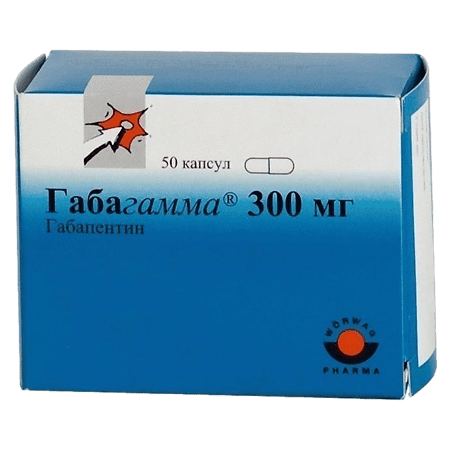No products in the cart.
Gabagamma, capsules 300 mg 50 pcs
€28.48 €23.73
Description
- complex therapy of partial seizures with or without secondary generalization in adults and children from 12 years old;
- pain syndrome in diabetic neuropathy;
- postherpetic neuralgia in adults.
Indications
Indications
complex therapy of partial seizures with or without secondary generalization in adults and children over 12 years of age;
pain syndrome in diabetic neuropathy;
postherpetic neuralgia in adults.
Special instructions
Special instructions
Although withdrawal syndrome with the development of seizures has not been observed during treatment with gabapentin, nevertheless, abrupt cessation of therapy with antiepileptic drugs in patients with partial seizures can provoke the development of seizures (see “Dosage and Administration”).
Gabapentin is not considered an effective treatment for absence epilepsy.
In patients requiring concomitant therapy with morphine, the dose of gabapentin may need to be increased. In this case, it is necessary to carefully monitor patients for the development of such a sign of CNS depression as drowsiness. In this case, the dose of gabapentin or morphine should be adequately reduced (see “Interaction with other drugs”).
Laboratory research. When gabapentin is added to other anticonvulsants, false-positive results have been reported when measuring urinary protein using Ames N-Multistix SG® test strips. To determine protein in urine, it is recommended to use the more specific method of precipitation with sulfosalicylic acid.
Impact on the ability to drive a car and use equipment. Patients should avoid driving and performing work that requires rapid psychomotor reactions.
Active ingredient
Active ingredient
Gabapentin
Composition
Composition
Active ingredient:
gabapentin 300 mg;
Excipients:
lactose;
corn starch;
talc;
gelatin;
titanium dioxide;
iron oxide yellow;
iron oxide red
Contraindications
Contraindications
hypersensitivity to any of the components of the drug;
acute pancreatitis;
hereditary galactose deficiency;
lactase deficiency;
glucose-galactose malabsorption.
With caution: renal failure; psychotic illnesses.
Side Effects
Side Effects
Cardiovascular system: symptoms of vasodilation or increased blood pressure, palpitations.
Digestive tract: flatulence, anorexia, gingivitis, abdominal pain, constipation, dental disease, diarrhea, dyspepsia, increased appetite, dry mouth or pharynx, nausea, vomiting, dental disease, increased activity of liver transaminases, hepatitis, jaundice, pancreatitis.
Blood system, lymphatic system: purpura (most often described as bruising resulting from physical trauma), leukopenia, thrombocytopenia.
Musculoskeletal system: arthralgia, back pain, increased bone fragility, myalgia.
Nervous system: dizziness; headache, hyperkinesis, muscular dyskinesia and dystonia, choreoathetosis, strengthening, weakening or absence of reflexes; dysarthria, ataxia, nystagmus, paresthesia, convulsions, confusion, increased fatigue, asthenia, amnesia, depression, impaired thinking, hostility, emotional lability, insomnia, anxiety, drowsiness, hallucinations.
Respiratory system: pneumonia, bronchitis, shortness of breath, respiratory infections, cough, pharyngitis, rhinitis.
Skin and subcutaneous tissues: acne, skin itching, skin rash, peripheral edema, erythema multiforme exudative (including Steven-Johnson syndrome).
Genitourinary system: urinary tract infection, impotence, urinary incontinence, acute renal failure.
Sense organs: visual impairment, amblyopia, diplopia, tinnitus, otitis media.
Other: fever, viral infection, weight gain, lability of plasma glucose levels in patients with diabetes mellitus, pain of various localizations.
Interaction
Interaction
Morphine: When gabapentin and morphine were coadministered, when morphine was taken 2 hours before gabapentin, there was a 44% increase in mean gabapentin AUC compared to gabapentin monotherapy, which was associated with an increase in pain threshold (cold pressor test). The clinical significance of this change has not been established; the pharmacokinetic characteristics of morphine did not change. The side effects of morphine when taken together with gabapentin did not differ from those when morphine was taken together with placebo.
No interactions were observed between gabapentin and phenobarbital, phenytoin, valproic acid and carbamazepine. The pharmacokinetics of gabapentin at steady state are similar in healthy subjects and patients receiving other anticonvulsants.
Concomitant use of gabapentin with oral contraceptives containing norethindrone and/or ethinyl estradiol was not accompanied by changes in the pharmacokinetics of both components.
The simultaneous use of gabapentin with antacids containing aluminum and magnesium is accompanied by a decrease in the bioavailability of gabapentin by approximately 20%. It is recommended to take gabapentin approximately 2 hours after taking the antacid.
Probenecid does not affect the renal excretion of gabapentin.
The slight decrease in renal excretion of gabapentin with concomitant use of cimetidine is probably not clinically significant.
Overdose
Overdose
Symptoms: dizziness, diplopia, speech impairment, drowsiness, lethargy, diarrhea and increased severity of other side effects.
Treatment: gastric lavage, administration of activated carbon, symptomatic therapy. Hemodialysis may be indicated for patients with severe renal failure.
Storage conditions
Storage conditions
At a temperature not exceeding 25 °C.
Shelf life
Shelf life
3 years
Manufacturer
Manufacturer
Dragenopharm Apotheker Püschl GmbH, Germany
Additional information
| Shelf life | 3 years |
|---|---|
| Conditions of storage | At a temperature not exceeding 25 °C. |
| Manufacturer | Artesan Pharma GmbH & Co. KG, Germany |
| Medication form | capsules |
| Brand | Artesan Pharma GmbH & Co. KG |
Related products
Buy Gabagamma, capsules 300 mg 50 pcs with delivery to USA, UK, Europe and over 120 other countries.












